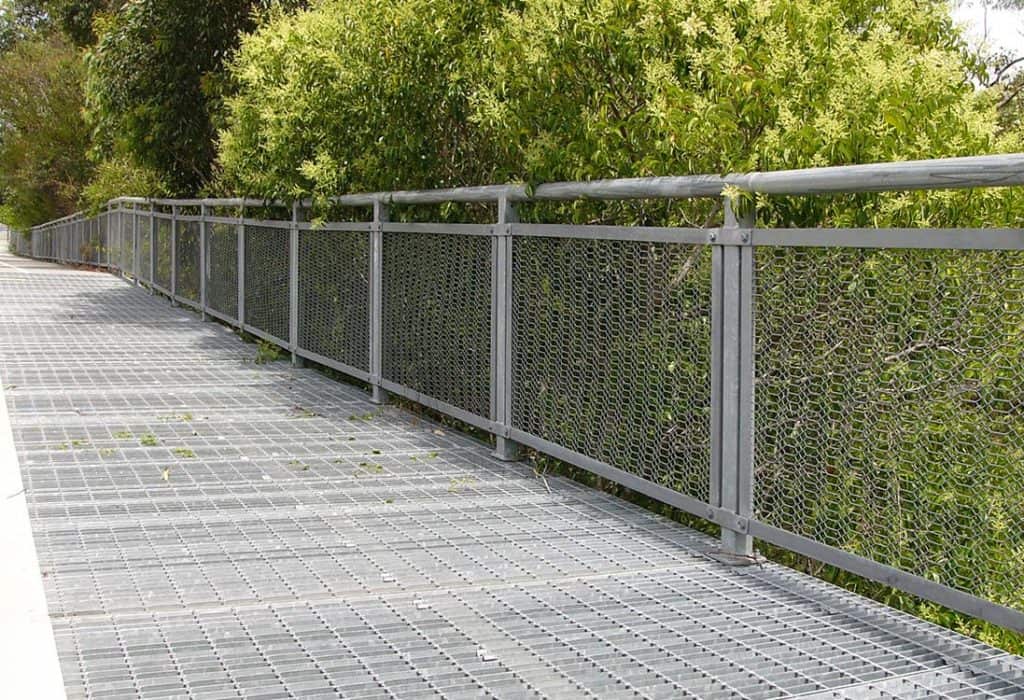Grating structures are typically designed to hold heavy loads with minimal weight and deflection but with maximum airflow and view through. Usual applications include industrial work platforms and walkways and protective coverings for drains. They are available in various materials like aluminium, stainless steel and FRP (Fibreglass Reinforced Polymer).
Selecting the right material for a grating project often includes a choice between steel and aluminium. So, which one serves the purpose better? Keep reading to find out.
Types of Grates
Grating can be used as a flooring surface, as described above, or as a drain grate cover used to protect the drain from debris. Grating effectively covers a pit and assists in water or fluid drainage, providing safe, walkable surfaces. They are extensively used in:
- City streets and walkways
- Driveways
- Entry mats in buildings
- Parks and playgrounds
- Commercial kitchens
- Laboratories and manufacturing facilities
- Entertainment Zones
1. Steel Grates
Steel grating can be manufactured from mild steel grating or stainless steel grating. Galvanised mild steel provides an ideal drain solution and is generally used across most exterior applications as it offers lasting durability. Stainless steel is usually chosen for its superior weathering resistance offering a more aesthetic look for a safe walking surface.
At Weldlok, we manufacture steel grating through the electro-forge welding process. This process involves applying pressure and heat to fuse round twisted steel crossroads to form load-bearing bars of various thicknesses and depths. We’re proud to have manufacturing capabilities in Australia allowing us to make grating locally.
2. Aluminium Grates
Aluminium gratings are best suitable for corrosive applications such as in water treatment plants or for applications near the ocean.
At Weldlok, we custom manufacture aluminium grates through a swagging process that involves swagging pre-punched load-bearing bars with square crossroads. We also provide surface treatments and slip-resistant top surfaces for our range of aluminium grating products.
Steel VS Aluminium Grates
Steel and aluminium have different properties, which makes them unique for specific applications.
1. Strength
Steel is harder than aluminium. Since steel is a resilient material, working with it is a bit tougher.
On the other hand, aluminium is easy to work with because of its malleability and flexibility. So, aluminium makes it easy to create specialised hole patterns. It also has a solid strength/weight ratio. However, steel still makes an ideal choice for drainage grates as they have better performance and are cost-effective.
2. Corrosion Resistance
Galvanised Mild Steel, stainless steel and aluminium grates all have excellent corrosion resistance properties.
Weldlok mild steel grating can be supplied untreated or Hot Dipped Galvanised in compliance with AS4680:2018. Galvanising provides steel protection from corrosion by dipping the item in a bath of molten zinc. A reaction between the steel and zinc creates an alloy that bonds to the surface of the steel with layers of zinc forming a tough, abrasion-resistant coating.
Stainless steel contains chromium as the corrosion resistance agent. It forms a passive layer of chromium oxide on the surface (from exposure to oxygen from air or water) that protects stainless steel grates from corrosion. Scratches cannot damage this layer as they are regenerative. In addition, stainless steel is non-porous, adding to its corrosion resistance properties.
Aluminium also has excellent corrosion properties in a way that they don’t rust or bleed like red oxide. Instead, it forms a self-repairing white oxide layer that protects aluminium drain grates from corrosion for a long time. They are an ideal choice for extremely wet surfaces and corrosive environments.
3. Thermal and Magnetic Properties
Aluminium is a good conductor of heat but is non-magnetic. When exposed to high temperatures, it warms up. On the other hand, steel is not a good conductor of heat, and its magnetic properties depend on its composition. Therefore, stainless steel drain grates do not warm up as aluminium grates. In both cases, products are designed to be fit-for-purpose based on application. Our team of experts are available for consultation of material selection.
4. Weight
Steel is comparatively much heavier or denser than aluminium. To be precise, stainless steel is 2.5 times denser than aluminium— and it does not dent, warp, or deform easily as aluminium which is specifically designed to be lightweight. Both materials offer weight to strength ratios for durability and performance.
Weldlok have developed and load tested an extensive array of products and sizes to ensure that selection of the right material for the load requirement is easy, our team can assist with expert advice for your project.
5. Aesthetics
Though aluminium and stainless steel look similar, steel grates have the most visual impact and offer the best value. Steel can be finished with a variety of surface finishes that comply with the Australian standards to offer a unique aesthetic appeal as per your needs.
Need advice on a project or specification? Contact a Weldlok expert.

